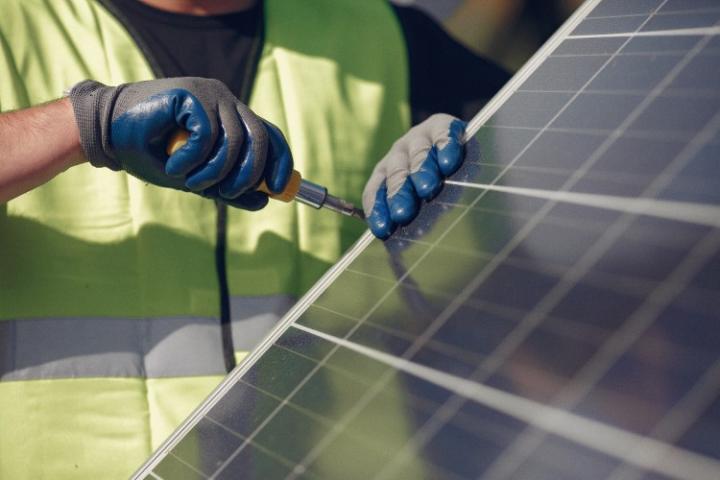Upgrading your home’s energy efficiency (known as retrofitting) not only reduces energy use and lowers bills, but also significantly cuts carbon emissions.
Upgrading insulation and windows or adding solar panels and a heat pump can boost your home's comfort, efficiency and sustainability.
Before making any changes to your home, we recommend seeking professional advice. A professional can tell you if the retrofit measures are appropriate, safe and effective for your property.
If you need an installer, TrustMark is the government endorsed quality scheme for home services.
Grants are available to fully fund or help pay for home energy improvements.
For more information on grants, go to our home energy improvement grants section.
Improving energy efficiency
When choosing where to start, it is often recommended to prioritise improvements to your home’s structure, such as through installing insulation and upgrading windows and doors. This is known as a fabric first approach and helps to improve the energy efficiency of your home.
Loft insulation
Loft insulation helps prevent heat escaping through the roof. It is often the easiest and most cost-effective upgrade.
Wall insulation
About a third of all heat lost in an uninsulated home escapes through the walls. Both cavity walls and solid walls can be insulated.
Floor insulation
Insulating the ground floor can help reduce heat loss from your home.
Window and door upgrades
Upgrading to double or triple glazed windows and installing well-sealed external doors can significantly reduce draughts and improve thermal performance. Draught proofing existing fittings is also a cost-effective alternative.
Improving airtightness is important. However, good ventilation is essential as it helps prevent dampness and keeps the air quality in your home healthy. Trickle vents and extractor fans can balance energy efficiency with fresh air.
Visit the Energy Saving Trust website for more information on how to reduce heat loss from your home.
Installing solar panels
Solar panels can significantly cut your electricity bills by generating clean, renewable energy from sunlight.
The Energy Saving Trust estimate that solar panels can save you up to £650 a year.

To maximise savings, consider adding battery storage, which allows you to store excess energy for use during the evening or on cloudy days. Alternatively, a solar diverter can send extra electricity to your hot water system. This helps cut down on gas or electric heating costs.
You may also benefit from the Smart Export Guarantee (SEG), which pays you for any unused electricity you export back to the grid.
Key factors such as roof orientation, angle and shading determine the suitability of a roof for solar panels. South-facing roofs with minimal shade offer the best performance.
Visit the Energy Saving Trust page on solar panels for more information.
Why not save money on solar panels from pre-vetted installers through our Solar Together group-buying scheme?

Installing heat pumps
Heat pumps are a low-carbon alternative to traditional fossil fuel heating systems. They use electricity to extract and concentrate heat from the air or ground and transfer it into your home.
There are 2 main types of heat pumps:
- Air source heat pumps absorb heat from the outside air and are the most common type in UK homes. Find out more about the permitted development criteria of air source heat pumps.
- Ground source heat pumps draw heat from the ground through buried pipes. They are typically more efficient but need more space and higher upfront costs.
Before installing either type of pump, it is important to complete insulation and glazing works first. This is because heat pumps produce heat at a lower temperature compared to gas boilers.
You may also need oversized radiators or underfloor heating.
Many households choose to install solar panels and battery storage as well as heat pump systems to reduce their reliance on the grid.
You may be eligible for a grant of £7,500 toward the cost of installing a heat pump through the Boiler Upgrade Scheme.
If you're thinking about a heat pump and want to see one working, check out the Visit a Heat Pump website. You can connect with real homeowners, learn from their experiences, and ask questions.
Find out what this Bracknell Forest resident thought about their air source heat pump.
Visit the Energy Saving Trust page on heat pumps for more information.
Energy Performance Certificates
Energy Performance Certificates (EPCs) show how energy efficient a home is. Homes are rated from A (very efficient) to G (inefficient). The national average score is D. The average across Bracknell Forest is currently C.
EPCs provide useful information on how to improve the energy performance of your home, and how each measure would impact the rating.
The government holds a list of all EPCs which can be accessed by searching your postcode. Find your EPC on GOV.UK - find an energy certificate.
If you do not have an EPC, you can find out how to get one by visiting GOV.UK - get a new energy certificate.
EPCs are valid for 10 years from the date of issue and are required if you’re selling or renting out your home. Getting an EPC certificate can cost between £60-£120.
Visit the Energy Saving Trust page on EPCs for more information.